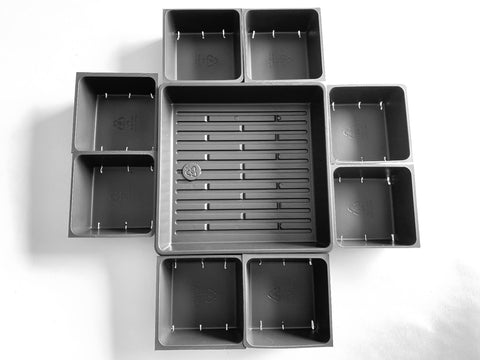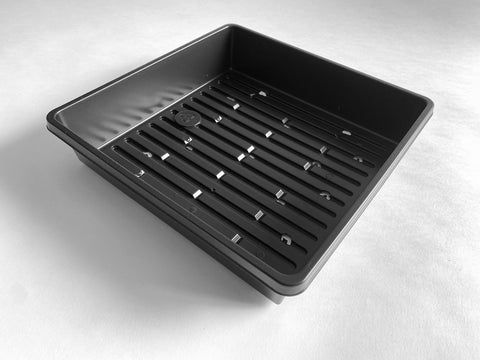




Kale Micro-Greens - Green Kale
Mild, sweet, flavor similar to other Brassicas. Green Kale produces another lovely, and exceptionally tasty Micro-Green.
This is the same seed we sell for Green Kale Sprouts.
Note: We sell Green Kale by the 1/2 pound.
Vitamins A, B, C, E and K
Calcium, Iron, Magnesium, Phosphorus, Potassium, Zinc
Carotene, Chlorophyll, Amino Acids, Trace Elements
Antioxidants
Protein: 30-35%
Nice, mild and nutty. Very tender.
The time it takes to grow a finished 5 - 14 days, or other crop (Micro-Greens, Grass, Greens) from a dry Seed. Note: This "finished" Sprout is our preference. you may grow them for as long as you want! In fact, we suggest that you taste them at every rinse to discover when you like them best.
How to Grow Kale Micro-Greens - Green Kale
- Plant 1-2 teaspoons of seed (for a 5x5 inch Tray) on thoroughly moistened medium.
- Cover your crop with another tray, or a plate - to keep light out and moisture in.
- Keep your medium moist by watering lightly as needed. Don't drench!
Use Coconut Coir and you likely won't have to water at all after planting! - When your plants have begun to show leaves, remove cover and move your crop to a well lit location.
- Harvest when the leaves are open and an inch or three tall (day 5-14).
- Cut just above the medium, with a scissors or sharp knife.

When growing Micro-Greens we start with a thoroughly moistened Medium, upon which we spread our dry seed, and then cover with a plate. The seed of most Brassicas is virtually identical. What you are seeing here is both Green Kale seed (on the left) and Red Russian Kale seed (on the right). Can You see the difference?;-)
We are using our Stainless Steel Sprouter, filled 3/4 full (more is even better) with our mix of 80% Coconut Coir, 20% Earthworm Castings, and 20% Vermiculite. Thoroughly moist means saturated, but not dripping.

24 hours later we are already seeing germination. Your crop remains covered, but there isn't much of a photo op in that, so this is what they look like - under the covering plate. You don't have to do anything to grow this crop except remove the cover, and I'll tell you when to do that - a few pictures down.

Same time - just closer. The fuzzy stuff you see is Not mold - those are Root Hairs - microscopic roots which grow off the tap (main) root. They are good. They are beautiful. If you have a magnifying glass, take a look. When we see Root Hairs on sprouts they disappear after Rinsing because the water makes them fall back along the tap root. Since we are not watering our Micros they stay visible. If you were to water now they would vanish. Enjoy them.

12 hours later.

At the same time - here's another look at those lovely Root Hairs.

12 hours later.

A closer look, at the same time.

A mere 12 hours later.
We can really see which side is Red Kale now.

12 hours later and it's time to remove the covering plate.
Move your tray to a well lit location. Sun is fine and dandy when growing Micro-Greens.

Look at what happens after just 12 hours of light!

12 hours later.

This is 24 hours later - just for a change of pace =;-)
As you've likely noticed, the Green Kale grows taller faster.
That isn't always the case, but it's common enough.
You can Harvest now if you wish. Actually you can harvest any time you like. Cut a few Micro-Greens off and see how you like their texture. That is the main thing that'll change as you continue to grow. Younger = more tender, but they remain texturally pleasing for several more days, at least. Harvesting is just a matter of cutting them off close to the Medium.

24 hours later.
This is just the Green Kale Micros.
Since I planted on that lovely Medium I described under the first picture - I didn't water my crop at all - until just after I took this picture.

I was cutting some off every day, but I didn't take this picture until 6 more days passed.
These are fresh cut and DElicious as well as gorgeous!
I'm writing this a week after I took this picture and I still have some growing as I seek True Leaves. I've got some, but they are not nearly as tender - though they still taste awesome.
My advice is to harvest when they are all Cotyledons (the first leaves), but experiment for yourself and see what you like best.
Micro-Greens don't store very well and they are Perfection when freshly cut, so eat 'em up and start another crop sprout farmer =:-)

When growing Micro-Greens we start with a thoroughly moistened Medium, upon which we spread our dry seed, and then cover with a plate. The seed of most Brassicas is virtually identical. What you are seeing here is both Green Kale seed (on the left) and Red Russian Kale seed (on the right). Can You see the difference?;-)
We are using our Stainless Steel Sprouter, filled 3/4 full (more is even better) with our mix of 80% Coconut Coir, 20% Earthworm Castings, and 20% Vermiculite. Thoroughly moist means saturated, but not dripping.

24 hours later we are already seeing germination. Your crop remains covered, but there isn't much of a photo op in that, so this is what they look like - under the covering plate. You don't have to do anything to grow this crop except remove the cover, and I'll tell you when to do that - a few pictures down.

Same time - just closer. The fuzzy stuff you see is Not mold - those are Root Hairs - microscopic roots which grow off the tap (main) root. They are good. They are beautiful. If you have a magnifying glass, take a look. When we see Root Hairs on sprouts they disappear after Rinsing because the water makes them fall back along the tap root. Since we are not watering our Micros they stay visible. If you were to water now they would vanish. Enjoy them.

12 hours later.

At the same time - here's another look at those lovely Root Hairs.

12 hours later.

A closer look, at the same time.

A mere 12 hours later.
We can really see which side is Red Kale now.

12 hours later and it's time to remove the covering plate.
Move your tray to a well lit location. Sun is fine and dandy when growing Micro-Greens.

Look at what happens after just 12 hours of light!

12 hours later.

This is 24 hours later - just for a change of pace =;-)
As you've likely noticed, the Green Kale grows taller faster.
That isn't always the case, but it's common enough.
You can Harvest now if you wish. Actually you can harvest any time you like. Cut a few Micro-Greens off and see how you like their texture. That is the main thing that'll change as you continue to grow. Younger = more tender, but they remain texturally pleasing for several more days, at least. Harvesting is just a matter of cutting them off close to the Medium.

24 hours later.
This is just the Green Kale Micros.
Since I planted on that lovely Medium I described under the first picture - I didn't water my crop at all - until just after I took this picture.

I was cutting some off every day, but I didn't take this picture until 6 more days passed.
These are fresh cut and DElicious as well as gorgeous!
I'm writing this a week after I took this picture and I still have some growing as I seek True Leaves. I've got some, but they are not nearly as tender - though they still taste awesome.
My advice is to harvest when they are all Cotyledons (the first leaves), but experiment for yourself and see what you like best.
Micro-Greens don't store very well and they are Perfection when freshly cut, so eat 'em up and start another crop sprout farmer =:-)
Yields approximately 4 Cups (1/2 lb.) of Sprouts
Seed Prep
Measure out 2 Tablespoons of seed* (slightly heaping) into your Sprouter or a strainer.
Rinse your seeds to remove dust and debris.
Soak
Transfer your seeds into your Sprouter (if necessary), or to a bowl.
Mix seeds up as you slowly add water to assure even water contact for all.
Add 2-3 times as much cool (70-80°F) water.
Allow seeds to Soak for 4-12 hours.
Do Not Ever Soak Again. Soaking is done only this one time.
We start counting days at this point - when the Soak is done (post-Soak is the phrase we use).
A crop of Leafy Sprouts usually takes 6 days - from This point in time to harvest.
Sprouting
Empty the seeds into your Sprouter (if necessary).
Drain off the soak water.
You can use it - it has nutrients in it. We use it on house plants.
Rinse thoroughly with cool (70-80°F) water.
Drain thoroughly.
Draining Thoroughly (Maniacally even) is the key to great crops. The smaller the seed (all Leafy Sprouts are small seeds) the more thorough you must be. Do Not skimp on Rinsing - but focus seriously on Draining.
If you need to see what we mean by Thorough Draining - check out our videos.
Set your Sprouter anywhere out of direct sunlight and at room temperature (70° is optimal) between Rinses.
This is where your sprouts do their growing. We use a counter top - in the corner of our kitchen, where the sprouter won't get knocked over by cats, dogs, kids or us. Indirect sunlight is fine, as is your regular room light - because light just does not matter much in the first couple days.
A plant can only perform photosynthesis when it has leaves. Until a plant has leaves, light has little if any effect. Sprouts also happen to like air-circulation, so don't hide your sprouts. When leaves do appear, this will be plenty of light for them to green up. You can also use Grow Lights if you like.
Rinse and Drain again every 8-12 hours for 3 days.
Always be sure to Drain very thoroughly. The most common cause of inferior sprouts is inadequate drainage. Even the best designed Sprouting Device holds water, so pay special attention to this step.
Greening
On the 4th day (post soak) relocate your sprouts, if necessary.
If you've been keeping them away from light - move them. Avoid direct sun as it can cook your sprouts, unless you are growing in a Tray Sprouter - in which case direct sunlight is great. Indirect sunlight is best for non-tray Sprouters but grow lights work well too. Experiment - you will be amazed at how little light sprouts require to green up. Photosynthesis is a marvel!
Continue to Rinse and Drain thoroughly every 8-12 hours.
Your last Rinse and Drain will be either at the end of day 5 or the start of day 6.
Always Drain Thoroughly.
Finishing
Your sprouts will be done about the end of day 6.
The majority of sprouts will have open leaves which will be green. You'll recognize them.
De-Hulling
Hulls are the thin coat on a seed. In most cases they separate themselves from the sprout. They are only a problem when it comes to the shelf life of your finished crop. We've eaten them for years and consider them extra roughage, but the crop looks better and lasts longer without them - so removing them is good.
You may De-Hull your sprouts at any time during day 5 or 6.
If you have a Salad Spinner - De-Hulling can be your last step. You can harvest and refrigerate them immediately after you finish.
You can also remove hulls prior to harvest...
If you are growing in a Jar - using the Coarse Mesh Screen will allow some hulls to float out through the screen while Rinsing. Repeating and agitating your sprouts will allow more hulls to escape.
If you're growing in an Easy Sprout Sprouter - transfer your sprouts to the Solid Base, fill with water, and agitate with a fork. This will help hulls get to the surface - where you can skim them off. When you've gotten all you can - move your sprouts back to the Growing Vessel, Rinse again, and Drain Thoroughly.
If you're growing in our Stainless Steel Sprouter you can get rid of most of the hulls by Rinsing Upside Down. Instead of writing words - let us direct you to our short video on the subject: Rinsing Leafy Sprouts Upside Down
Here is our video on De-Hulling.
Harvest
If you De-hulled with a salad spinner - you can go right to refrigeration. If not... Your sprouts are done 8-12 hours after your final Rinse and Very Thorough Draining. If we minimize the surface moisture of our sprouts they store much better in refrigeration, so we let them sit for 8-12 hours after that final Maniacal Draining.
Storing Your Crop
Transfer your sprout crop to a plastic bag or the sealed container of your choice. We have Produce Storage Bags that can extend shelf life substantially.
Leafy Sprouts are best within a week of harvest, but we've had some crops last for over a month in the fridge.
Great work sprout farmer!
*Amount of Seed to Use
* If using Sproutpeople's Single Harvest Pack - use the whole bag (for a one-quart Sprouter). It will produce a crop of approximately 8 ounces.
These seeds yield approximately 7:1 - which means the sprouts will weigh 7 times as much as the seed you start with, but, they will increase even more in volume - so don't start with more than 2 (heaping) Tablespoons per quart/litre of sprouter capacity.
Another garden variety Brassica, Kale comes in several leaf shapes and colors. We were offered this Green Kale by our farmer friend in Illinois. It sprouts and grows micro-greens exceptionally well, and the price was right - so we got some. We don't know if this is a seed he'll keep producing or not, so get it while we have it.
Green Kale may also be grown as a sprout, as detailed on our Green Kale page.
We also sell Red Russian Kale.
Note: Canadian and US researchers have found that Brassicas contain antioxidants such as sulfurophane. Kale is a Brassica.
Our green kale comes from farmer Ed in Illinois. He doesn't grow it every year, but it's great seed. Get it while you can.
Seed Shelf Life: 5 years. Store in cool, dark, dry spot. Store in freezer to extend shelf life.














